Rob Halford
| Rob Halford | |
|---|---|
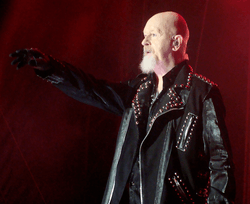 Rob Halford in July 2018 in Bulgaria | |
| Background information | |
| Birth name | Robert John Arthur Halford |
| Also known as | Metal God |
| Born |
25 August 1951 Sutton Coldfield, England |
| Genres | |
| Occupation(s) | Musician |
| Instruments | Vocals |
| Years active | 1969–present |
| Associated acts | |
| Website |
robhalford |
Robert John Arthur Halford (born 25 August 1951) is an English singer and songwriter, who is best known as the lead vocalist for the Grammy Award-winning heavy metal band Judas Priest and famed for his powerful wide-ranging voice and his his now-trademark leather-and-studs image, both of which became revolutionary in heavy metal.[1]. AllMusic says of Halford: "There have been few vocalists in the history of heavy metal whose singing style has been as influential and instantly recognizable... ...able to effortlessly alternate between a throaty growl and an ear-splitting falsetto".[2] Halford was voted number 33 in the greatest voices in rock by Planet Rock listeners in 2009.[3]
In addition to his work with Judas Priest, he has been involved with several side projects, including Fight, Two and Halford. In 1998, he came out as gay in an interview with MTV News.
Halford is widely referred to as the "Metal God" because of his powerful vocals and contribution to the metal genre.
Career
Early years
Halford was born in Sutton Coldfield, but raised on the Beechdale in Walsall,[4] a town to the northwest of Birmingham in England's West Midlands. His early influences included soul screamers, such as Little Richard, Janis Joplin and Robert Plant.[5]
Judas Priest

Halford was introduced to Judas Priest co-founder Ian Hill by his sister, who was dating Hill at the time.[6] Halford, a manager of a porn cinema,[7] joined the band as singer, bringing with him drummer John Hinch from his previous band, Hiroshima.
In August 1974, the band debuted with the single "Rocka Rolla", before releasing an album of the same name a month later. The next albums were Sad Wings of Destiny (1976); 1977's Sin After Sin; and 1978's Stained Class and Killing Machine (released in America as Hell Bent for Leather). 1979 brought their first live recording with Unleashed in the East.
In 1980, the band released British Steel, then Point of Entry in 1981, featuring the song "Heading Out to the Highway".
The 1982 album Screaming for Vengeance had a song, "You've Got Another Thing Comin'", which garnered strong US radio airplay, and the popular follow-up Defenders of the Faith was released in 1984. Turbo was released in April 1986. In May 1988, Ram It Down was released.
In September 1990, the Painkiller album dropped the 1980s-style synthesizers for almost all of the songs. Along with a change in musical style, the band's look changed as well. Halford emerged with all-new tattoos, including a bent Judas Priest cross on his right arm and ring around his other, as well as a few on his shoulders. He also began shaving his head.
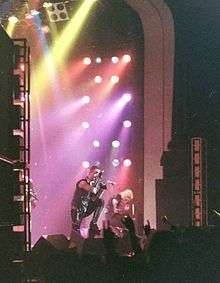
During the tour for Painkiller in August 1991 at a show in Toronto, Halford rode onstage on a large Harley-Davidson motorcycle, dressed in motorcycle leathers, as part of the show. He collided with a half-raised drum riser and fell off the motorcycle, breaking his nose.[8]
After regaining consciousness, Halford returned and performed the whole concert. In the band's Behind the Music episode, he named the accident as one of the events that caused the rift between him and the rest of the band that would eventually force them apart.
After spending nearly 20 years with Judas Priest, Halford announced to the band on 4 July 1991 that he was leaving, and he also sued their label, Sony, for restrictive practices. Halford would leave the band in May 1992.
Fight, 2wo and Halford
Halford first formed the band Fight with Judas Priest drummer Scott Travis, bassist Jack "Jay Jay" Brown and guitarists Brian Tilse and Russ Parrish, recording two albums between 1993 and 1995: War of Words (1993) and, after Parish's departure and his replacement by Mark Chausee, A Small Deadly Space (1995). While the first one was a straightforward tough and solid metal record, the second record had a grungier sound, making it less appealing to fans who had developed a taste for his debut album.
Between the albums, Fight released an EP, Mutations, featuring War of Words studio versions, live cuts and alternate mixes. Immediately before this, Halford had recorded a track called "Light Comes Out of Black" for the 1992 movie Buffy the Vampire Slayer. The song featured music provided by Pantera, although their contribution is uncredited. After Fight, he collaborated with guitarist John Lowery in an industrial-influenced project called 2wo which was executively produced by Trent Reznor and released on his Nothing Records label.
Halford returned to his metal roots in 2000 with his band Halford and the widely acclaimed album Resurrection (2000), produced by Roy Z. He joined the Metal 2000 tour with Iron Maiden and Queensrÿche to support the album. A live album in 2001 was followed up by Crucible (2002).
Reunion with Judas Priest
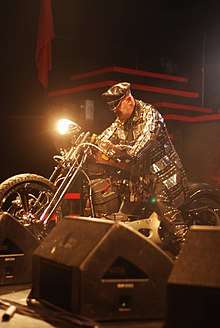
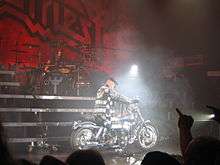
Halford's reunion with Judas Priest had been speculated about when he was no longer in the line-up, at least since the release of the Resurrection album, which some critics claimed sounded more like Judas Priest than the band's previous album Jugulator (1997). Halford initially ruled it out,[9] then reconsidered, stating in 2002 that "Gut instinct tells me that at some point it will happen".[10]
In July 2003, Halford returned to his former band, and they released Angel of Retribution in 2005. The world tour that accompanied the release marked the band's 30th anniversary. In 2008, Halford recorded Nostradamus with Judas Priest, and appeared with the band on the Metal Masters Tour.
In 2011, Judas Priest embarked upon what was billed as their final world tour as a group, titled the "Epitaph" tour.[11]
Subsequent to the tour's announcement, Halford stated that he would continue to move forward with his solo band.[12]
Despite the "final tour" announcement in 2011, Halford and Judas Priest (minus K. K. Downing, who left the group prior to the Epitaph tour) recorded another album, Redeemer of Souls, which was released in 2014, the album supported by a concert tour.
In 2017, Judas Priest began to work on another studio album with Halford. The album, Firepower, was released March 9, 2018.
Other activities
Halford has performed as the vocalist for Black Sabbath at three shows. He replaced Ronnie James Dio for two nights in November 1992, when Dio elected not to open a show for Ozzy Osbourne. Halford also filled in for Osbourne in Black Sabbath on 26 August 2004 (one day after Halford's 53rd birthday) at an Ozzfest show in Camden, New Jersey, since Osbourne could not perform due to bronchitis.[13]
In early 2008, Halford expressed a desire in making a black metal album, citing encouragement from former Emperor frontman Ihsahn.[14] He said he'd "love to but it's all about finding the time". He provides his voice to the video game Brütal Legend, released in October 2009, where he voices General Lionwhyte, as well as the leader of the Fire Barons, he heavily influenced the appearance of the latter.[15]
In 2002, Halford had a small role as a sex shop assistant in the film Spun.
Halford developed the clothing line Metal God Apparel with plans to develop retail sales through 2010.[16][17]
Halford had a brief cameo in a recent commercial for Virgin Mobile, appearing as a priest. His line in the commercial is "Let us pray". Judas Priest's 1977 album, "Sin After Sin" contained a song titled "Let Us Prey/Call for the Priest".[18][19]
In 2013, he did a collaboration with Five Finger Death Punch in their album "The Wrong Side Of Heaven and the Righteous Side of Hell" for the song "Lift Me Up". [20]
Personal life
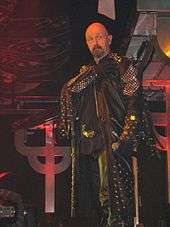
As of 2012, Halford lived in Phoenix, Arizona, U.S.[21]
Halford is able to play several instruments, including guitar, bass, harmonica, keyboards, and drums.[22]
In an interview with Motor Trend, he revealed that he has owned a variety of classic cars, including a 1970s Aston Martin DBS, a Chevrolet Corvette and a Mercury Cougar. He did not have a driver's licence until the age of 38;[23] as of 2010, his main car was a 2006 Cadillac DTS.[24]
Sexual orientation
In 1998, Halford publicly revealed his homosexuality.[25] He broke down in tears saying, "It's a wonderful moment when you walk out of the closet. Now I've done that and I've freed myself. It's a great feeling for me to finally let go and make this statement—especially to The Advocate, because this magazine has brought me so much comfort over the years. Obviously this is just a wonderful day for me."[26]
Halford describes himself as "the stately homo of heavy metal". He says that his announcement was "the greatest thing I could have done for myself." He also explains that he didn't announce it sooner due to the fear that he was going to cause harm to himself.[27]
Halford speaks negatively about the discrimination that the LGBT community still faces despite the broad social acceptance of homosexuality and the legality of same-sex marriage in some parts of the world. When asked about his thoughts on if his position as the frontman of Judas Priest has opened the door in positivity for some, he said, "That happened to me… I'll try and condense this as quickly as I can… I was away from Priest at the time, I was fronting a band called 2wo with John 5, who's now with Rob Zombie. And I was doing an interview with MTV and talking about music and blah blah blah, and very off the cuff, I said, 'Speaking as a gay man in metal…', blah blah blah. Well, the guy dropped his clip, the producer, because it was big news at the time. In reflection, would I have said that while was in Priest? The thing about gay people is that until we come out of the closet, we're always protecting other people: 'I can't do this, because it's gonna hurt so-and-so. We're trying to live the lives of other people, and that's the worst thing you can do. You've gotta learn to love yourself and live your own life. Then you can go out in the world and try and figure everything else out." He recalled that shortly after the interview, he began to fear negative reactions but was quickly inundated with messages of support from his colleagues and fans.[28]
Halford says that society hasn't changed much since his announcement as he would've hoped, "You’d think there would have been some kind of change and people would have moved on after such a long time. Now that I’m moving through my OAP heavy metal years (laughs), I thought a lot of it would be gone by now. And it's a shame. We don’t really get to spend a lot of time on this planet together, so there’s no point in wasting it being divided."[29]
In a September 2018 interview with the St. Paul Pioneer Press, Halford said that he knew of his sexuality in his youth, and that the current American administration "doesn't look particularly healthy right now. On the other side of it, (much has changed) so we can reach this level of equality. There is still a hell of a lot more to be done and it's taking forever. Sometimes it's like one step forward, two steps back. But these types of challenges only make us stronger, you know?" He then goes to say that walking out on stage as a gay man in a heavy metal band "is a victory. There’s something to be said about standing there and not saying a word. On the flip side of that, I make a hell of a lot of noise on that stage."[30]
Substance abuse
In Behind the Music Halford stated that hiding his sexuality during Priest's career caused him a lot of depression and isolation which led to his alcohol and drug abuse.
During the making of Judas Priest's Turbo album in 1986, Halford struggled with increasing substance abuse and violent feuds with his romantic partner. After the latter committed suicide[31] in front of Halford, he resolved to get clean.
He has been clean and sober since going to rehab following a painkiller overdose in 1986, stating that, before that point, he heavily abused drugs and alcohol.[32] He made an energetic recovery and his live performances during the subsequent Turbo tour were described as some of his strongest ever.
He was born and raised in a Christian home, and states the following about his upbringing, "On a religious, more spiritual foundation, that really, for me, has become more important since I became clean and sober on 6 January 1986. That was 25 years ago and I think that’s probably more important to me now, on a daily basis."[32]
In a 2015 interview with Western Canada's Rock N' Roll Breakfast Show, Halford gave a more detailed explanation looking back on the day he quit drugs and alcohol and how it affected his live performances and emotional well being since then, "It's a trail of sobriety that I really know for a fact has helped me in my career and in my life as a musician and as a person. I'd like to feel that I'm better in both worlds in that respect. I think I've improved in a lot of ways because of being able to stay clean and sober. But, you know, it is remarkable. And you can't do it by yourself — you have to use the tools that you're given by other people who have got your back and look out for you. And, again, it comes back, a lot of it, to my fans."
In a 2016 interview with The Washington Times, he was asked what part sobriety has played in the band's longevity, he responded, "Without it? Oh, I'd be dead. Literally, I would be dead."[33]
Halford credits the music as support for helping him through his addiction.[34]
Singing style and influences
Halford possesses a powerful operatic voice with a large vocal range which is marked by his full voiced, high-pitched screams and strong vibrato. However, with age, his lower range has matured and become more powerful. Along with Ronnie James Dio and Bruce Dickinson, Halford is one of the pioneers of the operatic vocal style later to be adopted by power metal vocalists and regularly appears near the top in lists of the greatest rock vocalists/front-men of all time.[35][36]
Halford describes himself as "a huge Queen fan" since they began and saw their very early shows.[37] He has called Freddie Mercury, the late lead singer of the band, his "ultimate hero" and expressed regret that he never got to know him.[38]
Halford listened to and was influenced by Little Richard, The Beatles, Elvis Presley, Janis Joplin, Ian Gillan and Robert Plant as a vocalist as well as influenced from David Bowie, Alice Cooper, King Crimson, Rolling Stones, Cream, John Mayall and Jimi Hendrix.[39][40]
Discography
Judas Priest
- Rocka Rolla (1974)
- Sad Wings of Destiny (1976)
- Sin After Sin (1977)
- Stained Class (1978)
- Killing Machine (1978)
- Unleashed in the East (1979)
- British Steel (1980)
- Point of Entry (1981)
- Screaming for Vengeance (1982)
- Defenders of the Faith (1984)
- Turbo (1986)
- Priest...Live! (1987)
- Ram It Down (1988)
- Painkiller (1990)
- Angel of Retribution (2005)
- Nostradamus (2008)
- A Touch of Evil: Live (2009)
- Redeemer of Souls (2014)
- Battle Cry (2016)
- Firepower (2018)
Fight
- K5 – The War of Words Demos (1992) (released in 2007)
- War of Words (1993)
- Mutations (1994)
- A Small Deadly Space (1995)
2wo
- Voyeurs (1998)
Halford
- Resurrection (2000)
- Live Insurrection (2001)
- Crucible (2002)
- Live in Anaheim (2003) (released in 2010)
- Halford III: Winter Songs (2009)
- Halford IV: Made of Metal (2010)
Other
- The Complete Albums Collection (2017)[41]
Guest appearances
- Krokus – Headhunter – vocals on "Ready to Burn" (1983)
- Surgical Steel – Surgical Steel (demo), vocals on "Smooth And Fast" (1984)
- Hear 'n Aid (1986)
- Recorded the song "Light comes out of Black" with Pantera for the Buffy the Vampire Slayer soundtrack (1992)
- Ugly Kid Joe – America's Least Wanted – backing vocals on "Goddamn Devil" (1992)
- Skid Row – B-Side Ourselves – vocals on "Delivering the Goods" in a live version (1992)
- Background vocals on the song "Hex 'n' Sex" for the album with the same title by the German band Brings (1993)
- Bullring Brummies, a studio session line-up that came together to contribute to the Nativity in Black tribute compilation album of Black Sabbath cover songs (1994).
- Queens of the Stone Age – Rated R – vocals on "Feel Good Hit of the Summer" (2000)
- Furious IV – Is That You? (2002)
- Spun motion picture (2002) – "Pornclerk" character
- Brütal Legend (2009) – Voicing the main villain Emperor Doviculus' minion General Lionwhyte, who is strongly based on the culture of glam metal. Also voiced the leader of the Fire Barons, who was directly modeled after his younger appearance.
- Five Finger Death Punch's album The Wrong Side of Heaven and the Righteous Side of Hell, Volume 1 (2013) – vocals on "Lift Me Up", performed live in Revolver Golden God Awards (2013).
- Ronnie James Dio tribute album, This Is Your Life (2014) – vocals on "Man on the Silver Mountain".
- The Simpsons – Singing a rendition of "Breaking the Law" in the episode "Steal This Episode" (2014).
- In This Moment's album Ritual (2017) – vocals on "Black Wedding".
References
- ↑ Daniel Bukszpan (2003). "The Encyclopedia of Heavy Metal".
- ↑ Prato, Greg. "AllMusic biography". AllMusic. Retrieved 4 November 2015.
- ↑ "Robert Plant voted rock's greatest voice". MusicRadar. 4 January 2009. Retrieved 12 September 2015.
- ↑ Bernard Perusse. Q&A with Rob Halford Archived 12 October 2007 at the Wayback Machine.. Montreal Gazette, 1 August 2007.
- ↑ "Four Decades of Hellfire with Judas Priest (Interview)". Rockcellarmagazine.com. Retrieved 1 February 2016.
- ↑ Archived 30 September 2007 at the Wayback Machine.
- ↑ Loudwire (2014-05-28), Judas Priest - Wikipedia: Fact or Fiction?, retrieved 2018-04-15
- ↑ Ling, Dave (25 December 2003). "Judas Priest: The Making of Painkiller". Daveling.co.uk. Archived from the original on 7 November 2004. Retrieved 20 July 2007.
- ↑ "Interview with Rob Halford – Part Two". Nyrock.com. Archived from the original on 9 March 2012. Retrieved 10 January 2015.
- ↑ Hoaksey, Mark: "Interview with Rob Halford", Power Play Issue 35, July 2002.
- ↑ "Judas Priest announce farewell EPITAPH World Tour!!". Judaspriest.com. 7 December 2010. Retrieved 19 October 2012.
- ↑ "Rob Halford on Judas Priest's Final Tour". Blabbermouth. Archived from the original on 11 December 2010. Retrieved 8 December 2010.
- ↑ "Ozzy Osbourne Replaced By Rob Halford At Black Sabbath's Camden Gig". Blabbermouth.net. 26 August 2004. Retrieved 1 February 2016.
- ↑ "Exclusive: Rob Halford's Black Metal album". Metalhammer.co.uk. 21 January 2008. Archived from the original on 10 September 2012. Retrieved 19 October 2012.
- ↑ Decibel Magazine, 19 April 2009.
- ↑ Campagna, Cathy A. (30 November 2009). "Interview with Rob Halford: A Metal God Christmas". The Aquarian Weekly. Retrieved 3 June 2010.
- ↑ Saulnier, Jason (16 April 2011). "Rob Halford Interview, Judas Priest Singer talks Rare Recordings". Music Legends. Retrieved 3 May 2013.
- ↑ Rob Halford in Virgin Mobile Commercial Archived 25 July 2010 at the Wayback Machine., Robhalford.com (20 July 2010); retrieved 21 May 2011.
- ↑ "Rob Halford Launches Own Clothing Line". SMNnews.com. Retrieved 10 January 2015.
- ↑ https://en.wikipedia.org/wiki/The_Wrong_Side_of_Heaven_and_the_Righteous_Side_of_Hell,_Volume_1
- ↑ Staff. "Halford MySpace website". Myspace.com. Retrieved 19 October 2012.
- ↑ "Rob Halford". Jugulator.net. Retrieved 18 May 2014.
- ↑ Rob Halford, Judas Priest Lead Singer First Car. Motor Trend; retrieved 21 May 2011.
- ↑ Rob Halford, Judas Priest Lead Singer Celebrity Drive. Motor Trend; retrieved 21 May 2011.
- ↑ "Rob Halford Discusses Sexuality Publicly for the First Time". MTV News. 5 February 1998. Retrieved 24 May 2010.
- ↑ Wieder, Judy (2001). Celebrity: The Advocate Interviews. New York City: Advocate Books. p. 94. ISBN 1-55583-722-0.
- ↑ Petridis, Alexis (3 July 2014). "Judas Priest's Rob Halford: I've become the stately homo of heavy metal'". The Guardian.
- ↑ "JUDAS PRIEST's ROB HALFORD On His Life As Gay Man: 'In Some Parts Of The World, People Like Me Get Thrown Off Buildings'". Blabbermouth.net. Retrieved 26 August 2017.
- ↑ "JUDAS PRIEST'S ROB HALFORD: "IT'S 2018 AND WE STILL TALK ABOUT SEXUAL ORIENTATION, SKIN COLOUR, 'MY RELIGION'S BETTER THAN YOURS…'"". Kerrang!. Retrieved 8 August 2018.
- ↑ Raihala, Ross. "50 years of Judas Priest: 'Things couldn't be greater for the band'". St. Paul Pioneer Press. Retrieved 14 September 2018.
- ↑ Kielty, Martin. "Rob Halford: Drink and drugs nearly killed me". Classic Rock. Retrieved 14 April 2018.
- 1 2 The Montreal Gazette (1 August 2007) Q&A with Rob Halford Archived 12 October 2007 at the Wayback Machine.. Canada.com; retrieved 21 May 2011.
- ↑ "Rob Halford of Judas Priest: 'I'd be dead without sobriety'". The Washington Times. Retrieved 13 October 2016.
- ↑ Meinert, Kendra. "Judas Priest's Rob Halford: 'I'm a 66-year-old metalhead but I feel like a heavy metal kid'". Green Bay Gazette. Retrieved 28 March 2018.
- ↑ "The 50 Greatest Metal Front-men of All Time!". Roadrunnerrecords.com. Retrieved 1 August 2010.
- ↑ "Hit Parader's Top 100 Metal Vocalists of All Time". Hearya.com. Retrieved 1 August 2010.
- ↑ "Rob Halford Tells Nikki Sixx That Adam Lambert Is Doing An 'Extraordinary' Job Fronting Queen". Blabbermouth.net. 10 July 2014. Retrieved 10 September 2015.
- ↑ Wilkinson, Roy (20 May 2010). "How Judas Priest invented heavy metal". The Guardian. London, UK. Retrieved 10 September 2015.
- ↑ Mastropolo, Frank. "Four Decades of Hellfire with Judas Priest (Interview)". Rock Cellar Magazine. Retrieved 7 December 2015.
- ↑ "Rob Halford: the 10 records that changed my life". MusicRadar. Retrieved 2018-04-23.
- ↑ "Rob Halford's Work Outside Of Judas Priest Spotlighted On 'The Complete Albums Collection'". Blabbermouth.net. Retrieved 6 June 2017.
External links
| Wikimedia Commons has media related to Rob Halford. |